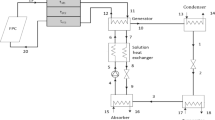Abstract
This article presents a numerical study of an Evacuated Tube Collector (ETC) based Ammonia-Water absorption refrigeration system. This system utilizes solar energy as an energy source and does not depend on conventional energy sources for its operation. The present system involves the use of hot water as an energy carrier for generator in an absorption system. The analysis system is based on computational model being developed and the thermodynamic properties of working fluids have been used from the computer code. The variation of performance parameters such as heat load of different components, exergy loss, COPCOOLING, COPHEATING and Exergy efficiency are studied with varying generator temperature. The results indicate that COPCOOLING as well COPHEATING lies in the range of 0.012–0.498 and 1.012–1.498 respectively and the values obtained are based on the maximum available solar intensity of 0.9 kW/m2 which corresponds to the collector area of about 431.7 m2 and hot water in the range of 90 °C. It is concluded that the maximum exergy loss is in generator and it is lowest in condenser. The ETC based absorption refrigeration system can be powered by renewable energy sources and does not employ ozone depleting substances.




Similar content being viewed by others
References
Adewusi SA, Zubair SM (2004) Second law based thermodynamic analysis of ammonia-water vapor absorption refrigeration system. Energy Convers Manag 45:2355–2369
Ahlby L, Hedgett D, Berntsson T (1991) Optimization study of compression/absorption cycles. Int J Refrig 14:16
Anand S, Gupta A, Tyagi SK (2013) Simulation studies of refrigeration cycles: a review. Renew Sustain Energy Rev 17:260–277
ASHRAE (1997) American Society of Heating, Refrigeration and Air-conditioning Engineers. Fundamentals Handbook, SI edition
Baik YJ, Park SR, Chang KC, Ra HS (2004) Korean J Air Cond Refrig Eng 16:1117
Bejan A, Tsatsaronis G, Moran M (1995) Thermal design and optimization. Wiley Publications, New York
Berlitz T, Cerkvenik B, Hellmann HM, Ziegler F (1999) A basis for the energetic assessment of the hybrid compression sorption systems. Proceedings of the International Sorption Heat Pump conference (ISHPC99)
Bulgan AT (1997) Use of low temperature energy sources in aqua-ammonia absorption refrigeration systems. Energy Convers Manag 38:1431–1438
Dincer I, Edin M, Engin Ture I (1996) Investigation of a thermal performance of a solar powered absorption refrigeration system. Energy Convers Manag 37:51–58
El Fadar A, Mimet A, Perez Garcia M (2009) Modeling and performance study of a continuous adsorption refrigeration system driven by parabolic trough collector. Sol Energy 83:850–861
Ezzine NB, Barhoumi M, Mejbri K, Chemkhi S, Bellagi A (2004) Solar cooling with the absorption principle: first and Second Law analysis of an ammonia—water double-generator absorption chiller. Desalination 168:137–144
Groll EA, Radermacher R (1994) Vapor compression cycle with solution circuit and desorber/absorber heat exchanger. ASHRAE Trans 100:73
Gupta A, Sharma S, Abrol S (2010) Energy and exergy analysis of ETC based solar air drying/water heating system. M. Tech Dissertation, Shri Mata Vaishno Devi University, Katra, India
Kilic M, Kaynakli O (2007) Theoretical study on the effect of operating conditions on performance of absorption refrigeration system. Energy Convers Manag 48(2):599–607
Kim DS, Infante Ferreira CA (2008) Solar refrigeration options—a state- of-the- art review. Int J Refrig 31:3–15
Kim B, Park J (2007) Dynamic simulation of a single – effect ammonia water absorption chiller. Int J Refrig 30:535–545
Klein SA, Alvarado F Engineering equation solver, version 9.083. F-Chart Software, Middleton, WI
Kotas TJ (1985) The exergy method of thermal plant analysis. Butterworth, London
Le Lostec B, Galanis N, Millette J (2012) Experimental study of an ammonia-water absorption chiller. Int J Refrig 35(8):2275–2286
Lee SF, Sherif SA (2001) Second law analysis of various double-effect lithium bromide/water absorption chillers. ASHRAE Trans 1:664–673
Li YW, Wang RZ, Wu JY, Xu YX (2007) Experimental performance analysis on a direct-expansion solar-assisted heat pump water heater. Appl Therm Eng 27:2858–2868
Manrique JA (1991) Thermal performance of an ammonia-water refrigeration system. Int Commun Heat Mass Trans 18(6):779–789
Mazloumi M, Naghashzadegan M, Javaherdeh K (2008) Simulation of solar lithium- bromide water absorption cooling system with parabolic trough collector. Energy Convers Manag 49:2820–2832
Ozgoren M, Mehmet Bilgili M, Babayigit O (2012) Hourly performance prediction of ammonia- water solar absorption refrigeration system. Appl Therm Eng 40:80–90
Pilatowsky I, Rivera W, Romero RJ (2001) Thermodynamic analysis of monomethylamine-water solution in a single stage solar absorption refrigeration cycle at low generator temperatures. Sol Energy Mater Sol Cells 70:287–300
Ravikumar TS, Suganthi L, Samuel AA (1998) Exergy analysis of a solar assisted double effect absorption refrigeration system. Renew Energy 14:55–59
Shah RK, Sekulic DP (2003) Fundamentals of heat exchangers design. John Wiley & Sons, New York
Tierney MJ (2007) Options for solar-assisted refrigeration-trough collectors and double- effect chillers. Renew Energy 32:183–199
Tyagi VV, Pandey AK, Giridhar G, Bandhopdhayay G, Park SR, Tyagi SK (2012) Comparative study based on exergy analysis of solar air dryer using temporary thermal energy storage. Int J Energy Res 36:724–736
Vargas JVC, Ordonez JC, Dilay E, Parise JAR (2009) Modeling, simulation and optimization of a solar collector driven water heating and absorption-cooling plant. Sol Energy 83:1232–1244
Acknowledgments
The financial assistance under Project No. 22/541/10-EMR-II from the Council for Scientific and Industrial Research (CSIR), New Delhi, India for this study is highly appreciated.
Author information
Authors and Affiliations
Corresponding author
Rights and permissions
About this article
Cite this article
Anand, S., Gupta, A. & Tyagi, S.K. Renewable energy powered evacuated tube collector refrigerator system. Mitig Adapt Strateg Glob Change 19, 1077–1089 (2014). https://doi.org/10.1007/s11027-013-9461-3
Received:
Accepted:
Published:
Issue Date:
DOI: https://doi.org/10.1007/s11027-013-9461-3




